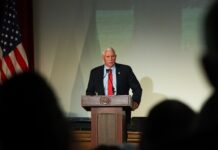Five candidates for the position of provost and vice president of academic affairs at Slippery Rock University will visit campus in November. As part of their visits, each candidate will deliver a public presentation and answer questions during an open session.
Dr. Abbey Zink, otherwise known as “Candidate B,” presented to students, staff, faculty, alumni and community members on Monday at 3:30 p.m. in SSC room 321. Zink holds a Ph.D. in English from Northern Illinois University and has over a decade of experience in academic leadership, including her time as Dean of the College of Humanities and Social Sciences at Sam Houston State University (SHSU).
Zink began her presentation by applauding SRU for being named a “Great College to Work For” by ModernThink and earning a place on the National Honor Roll.
“You’re all clearly doing really great work here in Slippery Rock,” Zink said.
She then moved her focus to students – particularly, non-traditional students. She said that all across the country, universities have stopped thinking about students as just “undergraduates” and “graduates.”
She added that there are people within multiple generations currently working to earn degrees: older, non-traditional students from Generation X are earning a multitude of degrees, ranging from bachelors to doctoral degrees; transfer students, traditional undergrads and first-time freshmen are generally Millennials and Generation Z.
“All of these students need something different, they’re not the same,” Zink said. “The market has become so much more diverse and complex, and universities who think of students as only traditional undergraduates and graduates are pretty much dropping the ball.”
She added that at SHSU, veterans, under-represented and first-generation students make up a pretty large percentage of their student population; different things can be offered for these types of students.
“That’s the trick to succeeding as a university: thinking about your students in different ways,” Zink said. “The universities that are thriving are the ones that focus on different types of students and their backgrounds.”
At SHSU, they focus on data analytics to examine how they can better serve their students. She said that if they see better retention rates among female veterans than male veterans or dropping retention rates among students of color, they can figure out why this is happening and how they can resolve the situation.
Zink said that thriving universities also create and nurture networks with community colleges and high schools in order to recruit potential students and increase enrollment. She said they also have networks with community organizations and create cohorts with organizations so that people currently in the workplace can earn their degrees while continuing to work.
She gave the example of Arizona State University’s partnership with Starbucks, which allows their employees to earn a degree through ASU, tuition covered by the company, while working. She added that university partnerships with corporations also better enables students to successfully search for jobs following graduation.
“It’s not enough to just stop by institutions, drop off a flyer and hand someone a business card,” Zink said. “You have to nurture those relationships.”
She said that one thing she is very passionate about is fostering innovation on college campuses. She’s seen other universities create spaces designed for collaboration and innovation – she exemplified Georgetown University’s Red House, which is described as “a place to meet and share ideas, a space for innovation.” It’s the home of the university’s Designing the Future(s) initiative, which brings students, staff and faculty together to develop new curricular and co-curricular structures.
“I love this idea of crowdsourcing, getting people around a table,” she said. “Some of the most innovative ideas on my campus and other campuses I’ve served have come from staff members who are doing the work every day.”
On SHSU’s campus, there are shared spaces for students to collaborate and foster innovation, but Zink said they don’t have anything like this yet for staff and faculty. A space like this for staff and faculty is in the works though, she said.
“We’re going to call it Katalyst for our mascot, Sammy the Bearkat,” she said. “We’re getting ready to launch in the spring.”
She added that many people believe that if an idea isn’t “an out-of-the-park homerun,” it’s not innovation, but she says that isn’t the case. She said one thing she’s learned from her years of experience is that innovation is-campus specific and that small changes sometimes have greater impact than one big, systemic change.
“What’s innovative on one campus may not be innovative on another,” Zink said. “Slippery Rock is doing a lot of things that would be innovative on a lot of other campuses.”
Zink said she’s also very passionate about diversity and inclusion. She explained that she’s worked at very diverse campuses; Western Connecticut State University was about 20% under-represented during her time there, Texas A&M University at Kingsville’s population was 67% Hispanic and SHSU is 42% under-represented.
She said she’s also done a lot of work for diversity and inclusion initiatives, including forming the Diversity and Inclusion Committee within the College of Humanities and Social Sciences at SHSU. She explained that she has led efforts to increase faculty diversity and aligning their hiring processes with best practices, reporting that SHSU has made great progress on both fronts.
“I’ve got these great students coming to me asking for structured conversations and programming about these issues, so I brought these people together to form this committee,” Zink said. “The committee has become so popular that people from other colleges and student affairs have joined, and we’ve partnered with organizations all over campus.”
She said the committee partnered with other student organizations to form the Diversity Reading program; each semester, students who participate in the program are offered and commit to reading a book that touches on pressing cultural issues, then these students are invited to a large discussion event facilitated by university staff and faculty.
Zink answered several audience questions, many related to topics such as external grants and funding, online programs, retention and why she wants to work at SRU.
She said she loves the size of SRU’s campus; it’s big enough to host special events for students, but it’s small enough that she can get to know a lot of people. She said even though she has been working at SHSU for six years, she is still meeting people for the first time because it’s such a large campus.
She added that she loves what SRU has been doing and the progress that’s been made, and she feels SRU could challenge her.
“I miss having four seasons, and being a Marshall University grad, I love wearing green,” she joked. “Aside from that, I want to be somewhere I can grow, learn and make a difference, and I feel like I can do that here.”
The remaining three candidates will present Nov. 18, Nov. 21 and Nov. 25 in SSC room 321 at 3:30 p.m.









